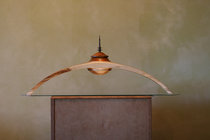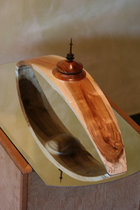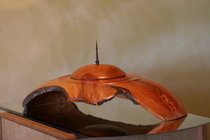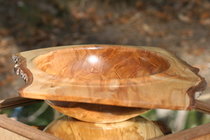As was mentioned in a prior thread there doesn't seem to be much past discussion regarding turning square platters. The form appeals to me and optimally I'd love to turn something large enough to function as a cheese platter for instance. That said, the possibility for personal injury due to sharp corners somewhat terrifies me. It isn't so much difficulty seeing corners at say 1,000 rpm, more so the reality of what could happen if the blank ever came off the lathe. Securely holding pieces while turning is paramount to us all and we discuss it often as we should. It's that important. Still, accidents happen. Even a precise tenon or recess can fail. A faceplate can be used while turning the outside/bottom but would be challenging to use while turning the inside/top. In addition, when turning a shallow platter, it seems difficult to stand out of the line of fire at certain points in the process. We don't want to be there. Looking at a piece of quatersawn white oak yesterday I thought how attractive a 12" x 12" square platter could look. Then the little voice inside me said "Don't do this, you need more information." Am I overreacting? Have you turned a larger square platter safely? Any sage advice is greatly appreciated!
-
It's time to cast your vote in the November 2025 Turning Challenge. (click here for details) -
Congratulations to Dave Roberts for "Low Rider" being selected as Turning of the Week for December 1, 2025 (click here for details) -
Welcome new registering member. Your username must be your real First and Last name (for example: John Doe). "Screen names" and "handles" are not allowed and your registration will be deleted if you don't use your real name. Also, do not use all caps nor all lower case.
You are using an out of date browser. It may not display this or other websites correctly.
You should upgrade or use an alternative browser.
You should upgrade or use an alternative browser.
Can you turn a larger square platter safely?
- Thread starter Rip Littig
- Start date
Turn it round, when done, spend some time at sander sanding out 4 sides? There's a video on you tube of someone (can't remember who but I think he's a member here) showing how to do it.
Not quite what I was thinking of but here's one being made:
View: https://www.youtube.com/watch?v=o-BkyNiIElk&t=4s
Not quite what I was thinking of but here's one being made:
- Joined
- Apr 27, 2004
- Messages
- 9,300
- Likes
- 6,053
- Location
- Lakeland, Florida
- Website
- www.hockenberywoodturning.com
I’ve done a few using techniques I learned helping Jimmy clewes and Al Stirt do classes for our clubs.
See if you can find a video by either on square turning.
There is no need to be in the line of fire. Best to sand corners with the lathe off
Can sand in the round areas with the lathe moving.
A few students cut too deeply inside the corners sending the little triangles flying. To light to do any damage to folks wearin face shields.
See if you can find a video by either on square turning.
You can get more information by turning lots of 7” , 9”, and 10” squares.Then the little voice inside me said "Don't do this, you need more information."
If you follow Stirt of Clewes. And stay on your side of the toolrestseems difficult to stand out of the line of fire at certain points in the process.
There is no need to be in the line of fire. Best to sand corners with the lathe off
Can sand in the round areas with the lathe moving.
A few students cut too deeply inside the corners sending the little triangles flying. To light to do any damage to folks wearin face shields.
Last edited:
since a platter is fairly thin, not much weight to it, shouldn’t be more of a problem than any other piece if mounted securely. A recess works nicely for platters and you could start with a short screw chuck or between centers. I don’t think it’s more dangerous than any other blank, as long as you remember those corners.
- Joined
- Apr 27, 2004
- Messages
- 9,300
- Likes
- 6,053
- Location
- Lakeland, Florida
- Website
- www.hockenberywoodturning.com
One method is to glue waste strips on the edges. Turn a round platter.
Then band saw along the glue lines.
My first AAW Symposium I was room assist and for Vic Wood who turned a small plate using this technique.
He said “you can use a band saw can’t you?” I nodded he handed me the plate and said “go find a bandsaw in the trade shoe an cut along the glue lines.
Those are 4 scariest cuts I have ever made on a band saw.
He said good job when I brought it back so I guess my nervousness didn’t show in the cut.
Then band saw along the glue lines.
My first AAW Symposium I was room assist and for Vic Wood who turned a small plate using this technique.
He said “you can use a band saw can’t you?” I nodded he handed me the plate and said “go find a bandsaw in the trade shoe an cut along the glue lines.
Those are 4 scariest cuts I have ever made on a band saw.
He said good job when I brought it back so I guess my nervousness didn’t show in the cut.
Last edited:
Al Stirt is a great bowl and platter turner. Here's a video of him turning a square platter:
View: https://www.youtube.com/watch?v=mg0wuh_SapE
Also, the tool rest provides a bit of security against a loose piece flying off the lathe towards a turner that's staying out of the line of fire. I sometimes take a little comfort (from behind my faceplate) in the full-size Robust comfort rest that shields fingers with some steel plate when turning squares or natural edges where the air/wood ratio is changing. Haven't had one come off yet, but I try to be ready if it does.
EVERYTHING you put on a lathe has the potential to injure or kill you. If it really bothers you, forget about trying it. Your life won't be much different if you don't turn a square platter.
The engineer's conundrum is that you can never idiot proof anything because as soon as you do, some one invents a better idiot. There are some extra risks involved. More than anything, I would say use a straight tool rest and make sure you never put your fingers on the wood side of the tool rest. If you do, you will get in trouble. People get skinned knuckles from their chucks all the time. You just learn to keep your fingers out of the way, eventually. Start small, like 4 to 6 inch diameter and see how it goes.
robo hippy
robo hippy
john lucas
AAW Forum Expert
I gently ride the bevel on the area where the wood is round. I'm not cutting. I pull the tool out gently listening to the ticks until I get to the outside. Then I move the tool to the left and start my cut. Gentle pressure on the bevel is key to making a successful cut.
Make sure to scale up the jaws in proportion to the project- Vicmarc makes 4", 5",6",7" and 8" dovetail jaws I believe. With a properly sized tenon around 1/3 of the total diameter of the workpiece and fitting the true circle diameter of the jaws (slightly open), I don't know why there would be any unusually larger risk of tenon failure on this project. Anything CAN happen but a properly made appropriately sized tenon or recess rarely does fail. I do think you're right to listen to the little voice that says you're maybe not ready for this yet, but no reason why you can't work up to it starting with more like an 8" x 8" square shallow bowl. Here's a good video by Jimmy Clewes going over some of the considerations for square turning:
View: https://youtu.be/Vmz5BKXBGLA?si=HS0i4VJgg6Zvt_6t
I am working on this skill myself, slowly developing the confidence to go larger. There is something very appealing about square work to me, especially if the final wings curve up into sort of a gentle pagoda shape; it has a sort of Japanese/Zen vibe to me. I have turned some square jewelry trays and candle holder/incense burners from 5 up to about 8" inches. With the 14" PM tool-rest parallel to the face (and maybe a strip of flourescent-colored tape on it to remind me of the "no-go" zone when I think about it), it gets a little easier with each one. Following the fundamentals of recess sizing above, I have found that razor sharp tools, precise tool control on the bevel when cutting in from the wings as John Lucas suggests, and some serious speed can give nice, even cuts and smooth surfaces. If I can crank up to about 1500 rpm without too much vibration or flexing of the wings, I have also found that using my Alan Lacer Uber Skew with a fresh edge as an NRS for the finishing cuts, kind of sweeping across, can yield a really smooth finish.
Learning to turn squares and live edge bowls has been probably the two best styles for forcing me to develop the finer tool control that is upping my turning game.
Learning to turn squares and live edge bowls has been probably the two best styles for forcing me to develop the finer tool control that is upping my turning game.
- Joined
- Feb 28, 2021
- Messages
- 1,753
- Likes
- 1,571
- Location
- Roulette, PA
- Website
- www.reallyruralwoodworks.com
Agree 100%I am working on this skill myself, slowly developing the confidence to go larger. There is something very appealing about square work to me, especially if the final wings curve up into sort of a gentle pagoda shape; it has a sort of Japanese/Zen vibe to me. I have turned some square jewelry trays and candle holder/incense burners from 5 up to about 8" inches. With the 14" PM tool-rest parallel to the face (and maybe a strip of flourescent-colored tape on it to remind me of the "no-go" zone when I think about it), it gets a little easier with each one. Following the fundamentals of recess sizing above, I have found that razor sharp tools, precise tool control on the bevel when cutting in from the wings as John Lucas suggests, and some serious speed can give nice, even cuts and smooth surfaces. If I can crank up to about 1500 rpm without too much vibration or flexing of the wings, I have also found that using my Alan Lacer Uber Skew with a fresh edge as an NRS for the finishing cuts, kind of sweeping across, can yield a really smooth finish.
Learning to turn squares and live edge bowls has been probably the two best styles for forcing me to develop the finer tool control that is upping my turning game.
So, I plan to do more of those as time permits - I think it gives proof that it isn't the lathe that makes things better, it's the skill set learned - I'm sorta thankful now that I started learning on a crappy Harbor Freight lathe as it has forced me to learn very fine tool control among other techniques to compensate for the poor fit & finish of the lathe.... and I suspect I will find it far easier and faster to produce the same quality piece on a nice new Jet when I get it, though by no means necessarily better...
So, I would have no hesitation about turning square stock (or even cubes - make a 6-pointed bowl - 3 points up 3 points down) It just takes some careful planning, some thoughtful consideration of cuts and tool rest & physical placement (I like to wrap a strip of green color masking tape around the 4 (or 8) corners for better visibility of where the corners are at just as an added "out of the corner of the eye" visual reference to keep tools, tool rest , and hands/fingers well away) - If feeling doubtful , it is helpful to practice turning air on scraps (Same technique will be needed to turn natural edge bowls from logs) and I found it is good to have tool rest as close to work as possible, so frequent stops and adjustment are needed.. Place a piece of tape on tool rest and make reference marks where a cut is going to start before turning on lathe, too, helps to get a cut started on the outside corners - as someone else mentioned, start with the bevel rubbing without cutting somewhere closer to the center and then rock yourself back and pay attention to the "ticking" as wood kisses the bevel, and as soon as it stops, you know you're in place to start the cut on a corner (very lightly and very shallow cuts though to avoid tearout) Of course, getting the blank mounted on exact dead center is another thing that needs some precision to get a nice even look to the platter... (Or, you can just nip the 4 corners slightly rounded over instead of sharp points, that way any inaccuracy is a bit less obvious)
- Joined
- Apr 27, 2004
- Messages
- 9,300
- Likes
- 6,053
- Location
- Lakeland, Florida
- Website
- www.hockenberywoodturning.com
am working on this skill myself, slowly developing the confidence to go larger.
Great time to peek at the Stirt and clewes videos.
May influence your style slightly or reinforce your confidence.
Have fun
Be safe
Last edited:
In addition, when turning a shallow platter, it seems difficult to stand out of the line of fire at certain points in the process. We don't want to be there. Looking at a piece of quatersawn white oak yesterday I thought how attractive a 12" x 12" square platter could look. Then the little voice inside me said "Don't do this, you need more information." Am I overreacting? Have you turned a larger square platter safely? Any sage advice is greatly appreciated!
As others have remarked -- if there is a little voice telling you that this may not be a good idea -- LISTEN! If you haven't turned squares before, definitely get some experience beginning with smaller sizes first. Remember that the tips of a rotating 12x12 define a circle ~17" in diameter. That 17" figure is the relevant dimension, not 12". The outer 2-3" of that 17" require interrupted cuts. There is a lot of open air. And the speed of those those outer tips is remarkable -- at 1000 rpm, they are traveling at roughly 50 mph.
I've turned thin (4/4) disks over 20" in diameter, but those have continuous rather than interrupted cuts.
I'm not sure what would require getting into the line of fire. Any cutting should have the tool rest between you and the blank.
We all feel some apprehension when trying a project that may be beyond our skill level, something that requires us to push our envelope. But that's not what I'm hearing in your post.
If you feel frightened by a project, then don't make it. Get more experience, get some coaching, and when you feel reasonably safe, you'll be ready.
If you feel frightened by a project, then don't make it. Get more experience, get some coaching, and when you feel reasonably safe, you'll be ready.
Not exactly square, but involving all of the same challenges, is the piece shown in my 'avatar', which has a wing span of 24".
The overriding rule when I'm doing any pieces that involve interrupted cuts is to continuously say to myself "keep my fingers on my side of the toolrest, fingers on my side of the toolrest, fingers on my side of the toolrest".
Wear a very good safety shield, but everything else is just a matter of finding what works for you. A reverse scraping with the bowl is something I use a lot on the underside of the wings. Your cuts have to be delicate otherwise the wings will deflect and give you uneven (resonating) cuts.
You will know when you have got to 'large' when the piece roars like the propeller on a small aeroplane when it's spinning on the lathe!
I have never fiddled with gluing pieces on and removing them later. Many of my winged pieces retain natural edges on the wings anyway.
Here is more detail of the piece I used in my avatar...
And two other natural edge winged examples...
The overriding rule when I'm doing any pieces that involve interrupted cuts is to continuously say to myself "keep my fingers on my side of the toolrest, fingers on my side of the toolrest, fingers on my side of the toolrest".
Wear a very good safety shield, but everything else is just a matter of finding what works for you. A reverse scraping with the bowl is something I use a lot on the underside of the wings. Your cuts have to be delicate otherwise the wings will deflect and give you uneven (resonating) cuts.
You will know when you have got to 'large' when the piece roars like the propeller on a small aeroplane when it's spinning on the lathe!
I have never fiddled with gluing pieces on and removing them later. Many of my winged pieces retain natural edges on the wings anyway.
Here is more detail of the piece I used in my avatar...
And two other natural edge winged examples...
Squares are not bad. Its the large rectangles that become "interesting".
This one was both off center and eccentric. I got tired of the corners coming around so slow and took it off the lathe. Finished off the corners with a right angle grinder (don't tell anybody).
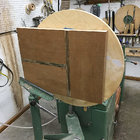
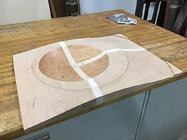
I found I really like turning the weird stuff on the outboard side of the lathe even when it will fit inboard. Makes it a lot easier to keep out of the line of fire. Use a longer tool rest and always keep your pinkies behind that tool rest.
This one was both off center and eccentric. I got tired of the corners coming around so slow and took it off the lathe. Finished off the corners with a right angle grinder (don't tell anybody).


I found I really like turning the weird stuff on the outboard side of the lathe even when it will fit inboard. Makes it a lot easier to keep out of the line of fire. Use a longer tool rest and always keep your pinkies behind that tool rest.
vert interesting piece!

